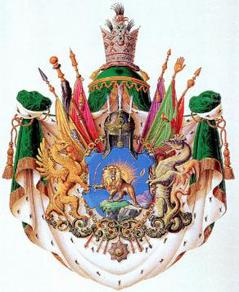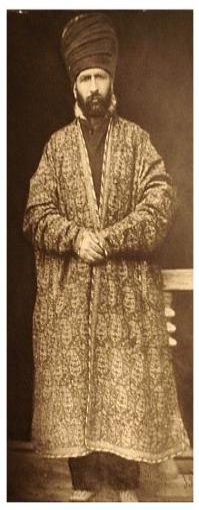Welcome to the Zarrinkafsch-Bahman (Qajar) Family Webpage!
This site is the official Homepage of the Zarrinkafsch-Bahman (Qajar) Family. It discusses the origin, history and genealogy of a Persian family of Qajar nobles and notables and contains as well the ancestry lines of the Zarrinnaal, Zarrinkafsh, Afshartous (Afshartoos), Wali (Vali) and Bahman (Qajar) families. The family goes back on one side up to the Kurdish Zarrinkafsh tribe from Sanandaj that we ruled, on the other side to our ancestor Bahman Mirza Qajar, a prince of the Qajar dynasty of Persia.
Introduction
Now the family is spread all around the world after several years of emigration and exile. To find a platform and forum for all of us and to join our common history, these sites were created - kindly supported by Mr Adenin Remy, Chief Editor of Almanach de Bruxelles and our Dear Cousin HH Prince Manoutchehr M. Eskandari-Kadjar, President of International Qajar Studies Association (IQSA) and Chief Editor of the Qajar (Kadjar) Dynasty Pages.
This side
should be a platform for our whole family. Many informations from
several sources and individuals built this work which is still in
progress. So, I would like to thank all those who had helped to create
these pages as well as I do appreciate any corrections!
* * * * *
The larger family all of Qajar origin at a gathering on Chateau de Bonmont, Cheserex in 2003.
* * * * *
For any suggestions, comments, additions or questions, please contact:
Arian K. Zarrinkafsch-Bahman (Qajar)
------------------------------------------------------------------------------------------------------------------------------------------------------------------------------
Glossary
There are several Persian technique terms and titles which are difficult to transfere exactly into European languages and sometimes translated wrongly at some sources. These titles were bestowed upon someone by the reigning Iranian ruler and not automatically hereditary.
Agha (Aga, Aqa): Turco-Pers. lit. "Master", meaning a village eldest, chief or a gentlemen at court, compareable to the English "Sir". In Iran of today this male title is in use as an appellation for "Mister".
Amir: Arab. lit. "Commander", meaning emir or ruler. In Safavid and Qajar Persia the tribal heads of the Kisilbash elite and the Quvanlu and Davalu leading branches of the Qajar dynasty were called with this male title, as well as some high-ranking military commanders.
Amir(-e) Kabir: Arab. lit. "Great Commander", meaning commander-in-chief. This military title of honour mostly was associated with Mirza Taqi Khan Farahani, Nasser od-Din Shah's first grand vizier.
Amir(-e) Lashkar: Pers. lit. "Commander of the Army", meaning Lieutenant-General.
Amir(-e) Tuman: Pers. lit. "Commander of 10,000", meaning Major-General. This title derived from Mongol time and was in the Qajar era one of the highest military ranks.
Amirzadeh: Pers. lit. "Born to an Amir", the honorific title of some distinguished courtiers' offspring, mostly of maternal royal descent.
Arteshbod:Pers. lit. "Military Leader", modern rank of a General, meaning Four-Stars-General.
Beyg (Beg, Beyk, Bak): Turk. lit. "Lord", actually meaning a tribal chief. In Seljuq time princely rulers of the provinces were called with this male title, during the Safavid and Qajar era the use for changed from a provincial vicegerent to a local subgovernor and finally to a gentlemen.
Beyg-lar-beygi (Beglerbegi): Turk. lit. "Lord of the Lords", meaning governor-general of an important province.
Beygom (Begum): Turk. lit. "Lady", female equivalent to Beyg. During the Seljuq and Safavid time until the reign of Fath Ali Shah Qajar the royal princesses were called this way as well.
Hakem: Pers. lit. "Governor", in the meaning of a district or city governor.
Khan: Turco-Mongol. lit. "Ruler", meaning a tribal or provincial lord. In Safavid time the mostly semi-autonomous tribal leaders in the provinces were called with this male title. In Qajar time governors and big landowner of old provenance were called this way by the public with the meaning of "Magnate", but everyone finally could add it as a sobriquet to his name.
Khanom: Pers. lit. "Lady", female equivalent to Khan. In Iran of today it is in use as an appellation for "Misses".
Lashkar-newis: Pers. lit. "Army Scribe", meaning muster-master and secretary of army supplyment.
Mir: Pers. lit. "Prince". Short form of amir, meaning often a semi-independent ruler of a Kurdish principality or "master" in context of the court, e.g. mir akhor for "master of the stable".
Mir Panj: Pers. lit. "Master of (a Division of) Five", Qajar military title meaning Brigardier-General.
Mirza: Short form of amirzadeh, used as sobriquet in addition to a first name.
After the name it means from Timurid time until the end of the Qajar dynasty a prince of the royal house, in its lit. meaning of "Born to an Amir". Before the name it means a clerk or bureaucratic, in its meaning of a literated person connected with the skills of fine arts like writing, caligraphy, poetry or painting.
Monshi or Monshi-bashi: Pers. lit. "Secretary" or "Chief Secretary", meaning ministerial or chancellor as an officer of the royal administration.
Nayeb os-Saltaneh: Arab. lit. "Deputy of the Monarchy", meaning in Qajar time Prince Regent, especially Fath Ali Shah's son and crown prince Abbas Mirza and after that Nasser od-Din Shah's favourite son Kamran Mirza are popular for this honorific royal title.
Sardar: Pers. lit. "Headman", meaning a military troop commander.
Sardar Sepah: Pers. lit. "Head of the Armed Forces", meaning Commander-in-Chief or Generalissimo. This title mostly was associated with Reza Khan as almighty minister of war in 1922.
Sarlashkar: Pers. lit. "Head of the Army", modern Major-General or Two-Stars-General.
Sartip: Pers. lit. "Leader", meaning Brigardier-General, modern rank of a One-Star-General.
Sepahbod: Pers. lit. "Leader of the Armed Forces", modern rank of a Lieutenant-General or Three-Stars-General.
Sepahdar: Pers. lit. "Chief of the Armed Forces", meaning a General.
Sepah Salar: Pers. lit. "Supervisor of the Armed Forces", meaning Field Marshal, highest military rank.
Shah: Pers. lit. "King", short form of the official male title of Persia's ruler since Sasanian times until the abolishment of monarchy in 1979, Shah-an-Shah-e Iran, meaning King of Kings (Emperor) of Persia or Iran.
Shahzadeh: Pers. lit. "Born to a King", meaning royal prince as offspring of a shah.
Soltan: Arab. lit. "Monarch" or "Ruler", meaning in Safavid time a provincial sub-governor but in Qajar time this male title was often used for the shah himself.
Wali (Vali): Arab. lit. "Vicegerent", meaning a governor-general of a great department. When the Safavids reached power the former independent princes and rulers of Georgia, Kurdistan, the Posht-e Kuh Bakhtiyaris of Loristan and the Arabs of the Sheikhs of Muhammara (Khuzistan) were called with this male title. In Qajar time with the lost of Georgia to the Russians the province of Azerbaijan was added to these regions, and finally all those who governed larger provinces were named this way.
Wazir: Pers. lit. "Minister", meaning a member of the governing cabinet or custodian of an administrative province.
---------------------------------------------------------------------------------------------------------------
Weblinks
There are several links in the web concerning with some other great Persian families:
There are several links in the web concerning with some other great Persian families:
http://www.vazirifamily.org (by the courtesy of Mr Kaveh Vaziri)
http://www.bakhtiarifamily.com (by the courtesy of Mrs Goli Bakhtiari)
http://www.Bakhtiari.ning.com (by the courtesy of Mr Dariush Panah)
http://sardari-iravani.org/ (by the courtesy of Mr Ali Amir Sardari Iravani)
http://khanakharab.com/ (by the courtesy of Mr Amir Pishdad).
To go to Family History- click here
This website was created by Arian K. Zarrinkafsch (Bahman-Qajar).




